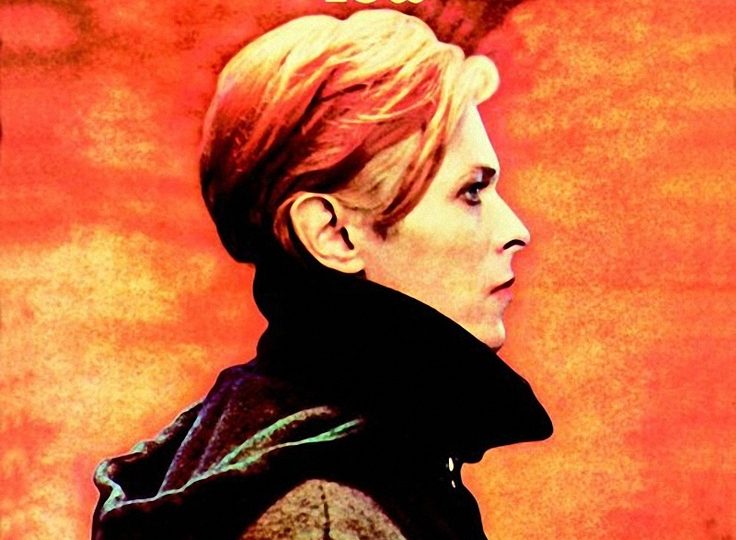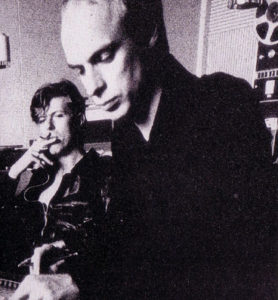
Low (1977): Bowie’s Most Important Transformation
After flirtations with the plastic soul-funk of a surprising Young Americans (1975) and a phenomenal Station To Station (1976), David Bowie decided to move from Los Angeles to Europe. He finally settled down in West Berlin, sharing an apartment with his friend Iggy Pop. Both thought that the German city would be a good place to rehabilitate together and finally kick off the incessant drug abuse. During his “Berlin Period” (1976-1978), Bowie also traveled and had recording sessions in France, Switzerland, and New York.
On his first days in the European continent, Bowie visited different countries and experienced several setbacks. The most scandalous one happened in the United Kingdom, specifically at Victoria Station in London. Problems emerged when various media outlets published a controversial picture in which Bowie seemed to make a Hitler salute. After that incident, one would expect Bowie to step back from associating himself with the Führer. But instead, during an interview with Playboy Magazine, Bowie declared that Hitler was “one of the first rockstars, quite as good as Jagger”. When everything intermingled, Bowie justified his behavior in an interview with The Daily Express, saying: “I’m Pierrot. I’m Everyman. What I’m doing is theatre, and only theatre. What you see on stage isn’t sinister. It’s pure clown. I’m using myself as a canvas and trying to paint the truth of our time on it. The white face, the baggy pants – they’re Pierrot, the eternal clown putting over the great sadness.” Bowie denied the Hitler salute and added that he had nothing to do with the Nazi movement. His companions immediately defended this, claiming that they had never been offended by racist comments. It makes sense if we consider that Bowie worked with musicians of different races and beliefs throughout his career and highlight the fact that Bowie shared a happy and prosperous marriage of 24 years (1992-2016) with Iman Mohamed Abdulmajid, a black muslim model and actress. She turned out to be the most important person in his life, their marriage lasted until Bowie’s final days.
Back in those controversial years, Bowie pointed out that drugs took a toll on his mental state, the act of  adopting the role of a cold and evil seducer like “The Thin White Duke” had been a great burden for him. It was the moment of a musical, spiritual and personal transformation. Although Bowie wanted to work with Iggy in Germany, they ended up in France. Specifically, in the Château d’Hérouville studio, a space that would witness their next movements. After a brief visit to Switzerland, Bowie came back to France and recorded part of Iggy Pop’s first solo album, The Idiot (1977). Later, both decided to finish the album’s recording in Germany, first in Munich and later in Berlin’s Hansa Studios. From here, Bowie decided to put all his efforts into a new project of his own. To carry out this task, he required the help of two musical legends: Brian Eno and Tony Visconti. In those days, Bowie had sympathy for the music of avantgarde and krautrock bands like NEU !, Cluster, Harmonia, Popol Vuh and Kraftwerk. The innovative textures and sounds of these bands gave Bowie’s inspiration a new boost and his new project found it’s roots on experimentation and the use of different electronic instruments.
adopting the role of a cold and evil seducer like “The Thin White Duke” had been a great burden for him. It was the moment of a musical, spiritual and personal transformation. Although Bowie wanted to work with Iggy in Germany, they ended up in France. Specifically, in the Château d’Hérouville studio, a space that would witness their next movements. After a brief visit to Switzerland, Bowie came back to France and recorded part of Iggy Pop’s first solo album, The Idiot (1977). Later, both decided to finish the album’s recording in Germany, first in Munich and later in Berlin’s Hansa Studios. From here, Bowie decided to put all his efforts into a new project of his own. To carry out this task, he required the help of two musical legends: Brian Eno and Tony Visconti. In those days, Bowie had sympathy for the music of avantgarde and krautrock bands like NEU !, Cluster, Harmonia, Popol Vuh and Kraftwerk. The innovative textures and sounds of these bands gave Bowie’s inspiration a new boost and his new project found it’s roots on experimentation and the use of different electronic instruments.
Low begins with “Speed Of Life”, an instrumental piece with heavy use of synthesizers and electric guitar, the listener instantly perceives the bucolic and enjoyable side of life. Then, the album gives way to “Breaking Glass”, a lyrical piece in which those past regrets are still haunting Bowie’s present. In the track “What in the World”, Bowie has a conversation with his own soul: he begins to raise that sense of existential emptiness and depression that plagued the life of the Thin White Duke. Later, “Sound And Vision” appears on stage with a magnificent set of guitars, and especially Bowie’s exquisite interpretation of saxophone and vocals. It is the undisputed hit of the album, and it follows a completely unconventional structure. An accident Bowie had with his Mercedes in Switzerland resulted in the song titled “Always Crashing In The Same Car”, a spectacular cacophony of guitars with some really suggestive vocal lines. “Be My Wife” is delightfully melodic, with an equally rich instrumentation. The first half of Low concludes with the instrumental “A New Career In A New Town”, inspired by Bowie’s own decisions and the search for a new era in his career.
The second side kicks off with the otherworldly ambient track “Warszawa”, which turns out to be the antagonist of the first side that we analyzed previously. The song is a faithful portrayal of the state of Warsaw in those times, where mystery collided with desolation. “Art Decade” also seems to evoke the sadness and fainting that prevailed in West Berlin, where Bowie resided. In “Weeping Wall”, Bowie raises the misery that gathered around the mournful wall that separated Germany into two territories. Finally, “Subterraneans” invokes the insignificance felt by the citizens of East Berlin during the Cold War (“Share bright failing star”). All these feelings of the album’s second half turned out to be a faithful portrayal of Bowie’s deteriorated state.
Low is probably Bowie’s riskiest musical leap and the first installment of the so-called “Berlin Trilogy”. The change of his original sound is radical, many critics and followers got turned off by the challenging and experimental ideas of the record. Initially misunderstood upon it’s release, Low is now considered an unmitigated masterpiece. It also helped Bowie to reconnect with himself, to recover both mentally and physically, and to start a new path of glory.
by Octavio Carbajal González
